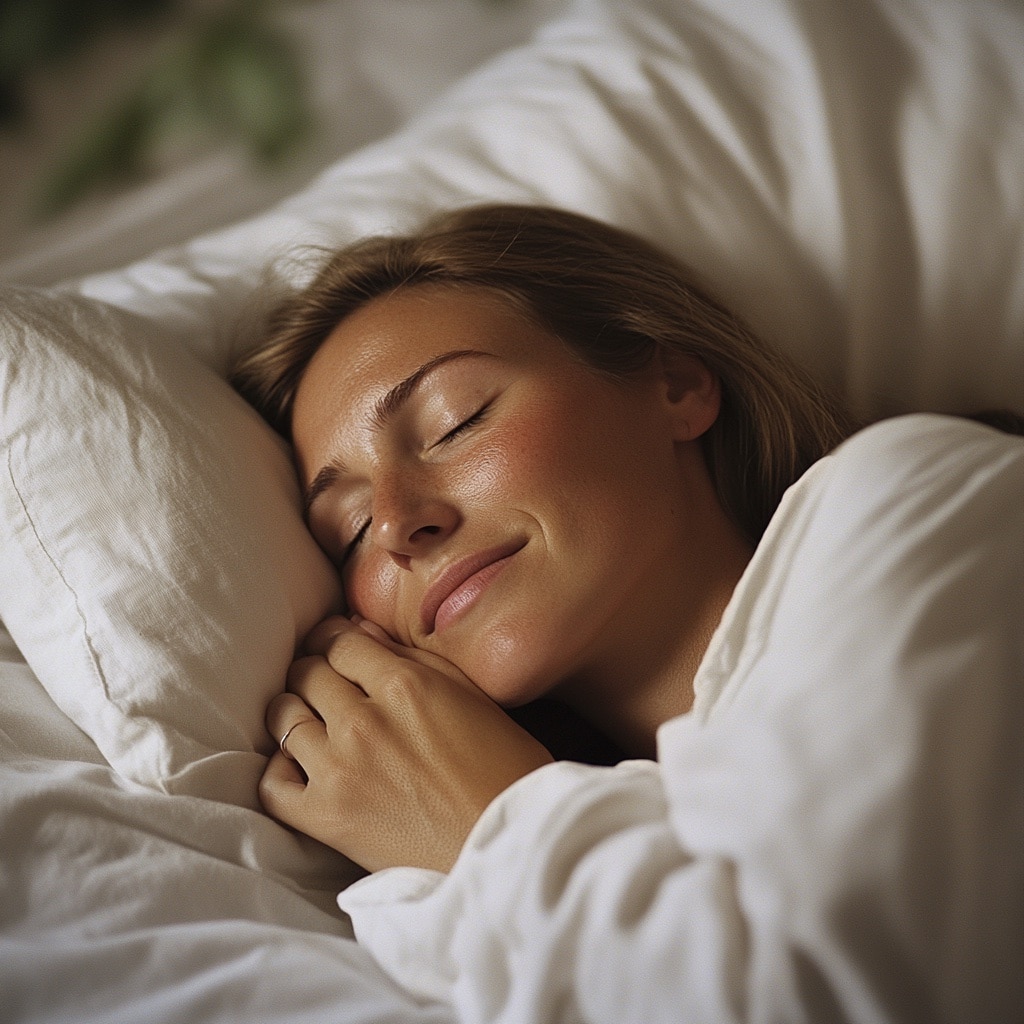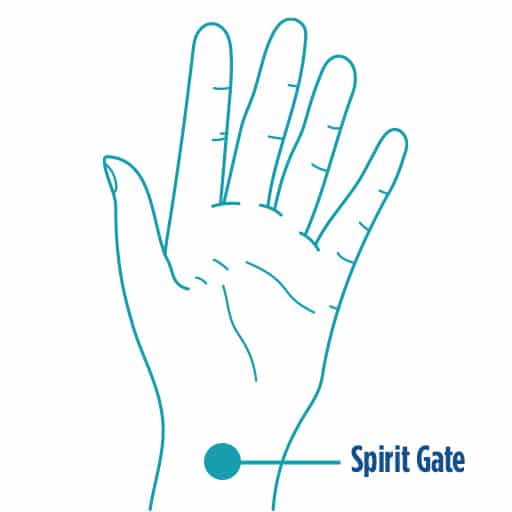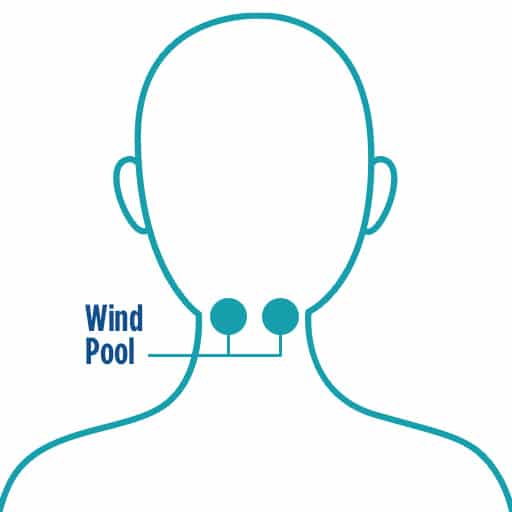Pressure point to sleep: Use Acupressure to conk out

It’s ancient Oriental wisdom.
There are pressure points on your body that can help you relax and sleep better.
These pressure points, when stimulated correctly, can promote relaxation, reduce stress, and improve sleep quality.
No money you have to spend. Nothing to put in your mouth to swallow.
In this article, we’ll explore some of the best pressure points for sleep, and how you can easily incorporate them into your bedtime routine.
What Are Pressure Points?
Pressure points are specific spots on your body which …
… when pressed or massaged, can relieve tension, improve circulation, and encourage relaxation.
This practice comes from Traditional Chinese Medicine (TCM) and is called acupressure. Unlike acupuncture, which uses needles, acupressure involves using your hands or tools to apply pressure to these points. It is believed to help restore balance in the body by promoting the flow of energy, known as “qi” (pronounced ‘chee’).
While more scientific studies are needed, many people find acupressure to be a helpful tool for better sleep.
How Do Pressure Points Help with Sleep?
When you apply pressure to certain points on your body, it can trigger relaxation responses. This can help:
- Calm the mind
- Reduce anxiety
- Relieve tension in muscles
- Promote deeper breathing
- Regulate your nervous system
These benefits make acupressure a natural, non-invasive way to improve your sleep without needing medication.

7 Best Pressure Points for Sleep
Here are seven effective pressure points you can use to help yourself fall asleep faster and sleep more soundly:

1. Spirit Gate (HT7)
Location: Inner wrist, in the small hollow below the hand crease.
The Spirit Gate is one of the most popular pressure points for promoting relaxation and easing insomnia.
How to Use:
- Gently press this spot with your thumb.
- Massage in a circular motion for 2-3 minutes on each wrist.
2. Three Yin Intersection (SP6)

Location: Inner leg, four finger widths above the ankle.
This point is known to help with insomnia, anxiety, and hormonal balance.
How to Use:
- Apply firm pressure and massage for 4-5 seconds.
- Repeat on both legs.
Note: Avoid this point if you are pregnant, as it may induce labor.

3. Bubbling Spring (KD1)
Location: Sole of the foot, in the depression when you curl your toes inward.
This point helps ground your energy and relieve insomnia.
How to Use:
- Press firmly with your thumb.
- Massage in a circular motion for a few minutes.

4. Inner Frontier Gate (PC6)
Location: Inner forearm, two finger widths down from the wrist crease.
This point is known to reduce anxiety and promote relaxation.
How to Use:
- Apply steady pressure and massage for 4-5 seconds.
- Use this point on both arms.

5. Wind Pool (GB20)
Location: Base of the skull, between the neck muscles.
This point helps relieve headaches and tension, which can interfere with sleep.
How to Use:
- Use your thumbs to apply deep, firm pressure.
- Massage in a circular motion for 4-5 seconds.

6. An Mian (Extra Point)
Location: Behind the ear, between the ear and the hairline.
This point is specifically known for promoting restful sleep.
How to Use:
- Apply light circular motions with your thumb or forefinger.
- Massage both sides for a few minutes.

7. Heavenly Pillar (BL10)
Location: On the neck, about one inch below the base of the skull.
This point can relieve stress, neck tension, and restlessness.
How to Use:
- Use your thumbs to apply firm pressure.
- Massage for a few minutes before bed.
How to Use Pressure Points for Sleep
To get the most out of acupressure, follow these simple steps:
- Choose Your Points: Don’t overdo it to start with. Pick just one or two pressure points.
- Apply Gentle Pressure: Use your thumb or fingers to press the point gently but firmly.
- Massage in Circular Motions: Move in slow circles for 30 seconds to a few minutes.
- Focus on Both Sides: When applicable, repeat on both sides of your body.
- Breathe Deeply: Take slow, deep breaths while applying pressure to enhance relaxation.
Incorporate this routine into your wind-down time 15-60 minutes before bed.
Additional Sleep Tips to Boost the Benefits of Acupressure
While pressure points can help, combining acupressure with good sleep hygiene will give you the best results. Here are some tips:
- Stick to a Sleep Schedule: Go to bed and wake up at the same time each day.
- Create a Relaxing Bedtime Routine: Dim the lights, avoid screens, and engage in calming activities.
- Limit Caffeine and Alcohol: Avoid these substances in the hours leading up to bedtime.
- Optimize Your Sleep Environment: Keep your bedroom cool, dark, and quiet.
- Use Natural, Non-Addictive Sleep Aids: There are several of these. We’ll be covering them in upcoming articles.
Are Pressure Points Safe for Everyone?
Pretty much!
That said, while acupressure is generally safe, there are a few precautions to keep in mind:
- Pregnant women should avoid certain pressure points, like SP6, which can induce labor.
- Avoid applying pressure to injured or bruised areas.
- If you have a chronic medical condition, consult your doctor before trying acupressure.
Final Thoughts on Using Pressure Points for Sleep
Acupressure is a natural, easy-to-use tool that can help you relax and improve your sleep. By stimulating specific pressure points, you may find yourself falling asleep faster and waking up feeling more refreshed. While more research is needed, many people have already found relief through this ancient practice.
Remember, acupressure works best when combined with other healthy sleep habits.
Give it a try and see how these simple techniques can help you enjoy better, more restful nights.
If You’re Having Trouble Falling Asleep …
Sometimes, despite good sleep hygiene, the hardest part is simply the drifting off at bedtime.
If this sounds familiar, melatonin might help.
- Melatonin Basics:
Melatonin is a hormone your body naturally produces to regulate the sleep-wake cycle. Taking a melatonin supplement can help reset a disrupted schedule, ease jet lag, or simply make it easier to fall asleep. - Liposomal Melatonin:
For those looking for an even more efficient option, liposomal melatonin is encapsulated in tiny “bubbles” called liposomes. This can help your body absorb and use the hormone more effectively. Many users report faster onset and better overall sleep quality with liposomal melatonin.
If you’d like to learn more about how melatonin works, check out The Science Behind Melatonin.

For further reading on the topic:
- Effects of Acupressure on Sleep Quality and Psychological Distress in Nursing Home Residents: A Randomized Controlled Trial
https://pubmed.ncbi.nlm.nih.gov/30797692/ - Effectiveness of applying auricular acupressure to treat insomnia
https://www.frontiersin.org/journals/sleep/articles/10.3389/frsle.2024.1323967/full - The effectiveness of acupressure in improving the quality of sleep of …
https://pubmed.ncbi.nlm.nih.gov/10496543/ - The effects of acupuncture on sleep disorders and its underlying mechanism: a literature review of rodent studies
https://www.frontiersin.org/journals/neuroscience/articles/10.3389/fnins.2023.1243029/full

